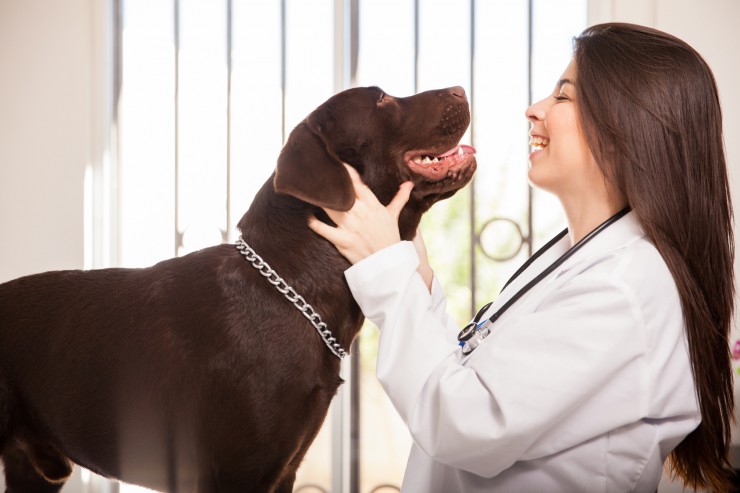

If your dog appears to be a little under the weather, acting oddly or otherwise not their usual selves, this generally presents a dilemma to the owner, who is torn between taking their dog along to the vet right away, or waiting to see how things progress instead of potentially making a needless trip and incurring the expense of a consult fee, just to be told that everything is fine.
During clinic hours, the best approach to this dilemma is to call the practice that you are registered with and speak to a vet or a veterinary nurse for advice, as they will be able to give you a much better idea of whether your dog needs to be seen immediately or not. However, out of hours, the dilemma becomes more pronounced; you will not be able to get basic advice over the phone, and instead, will need to commit to having a vet called out for an out of hours consult, which can potentially cost £100, or even more.
There is no right or wrong answer to this dilemma that suits every potential eventuality, but in most cases, it is better to be on the safe side if you are concerned, and either speak to your vet on the phone or make an appointment to go in. However, while no one can tell you by phone for sure that your dog is ok to stay at home without first seeing them, there are some situations in which your dog most definitely does need to be seen by a vet, and these situations can worsen quickly if they do not receive immediate care.
In this article, we will look at five canine crises that mean your dog needs to see a vet immediately. Read on to learn more.
If your dog is vomiting up blood or food and blood combined, especially if this is accompanied by a refusal to eat, general lethargy and other signs of sickness, your dog must see a vet right away.
Bloody vomit is of course never a good sign, and can often be indicative of certain canine health conditions that are not only serious, but that also tend to worsen to the critical stage very quickly, and your dog should be in the clinic being cared for if or when this happens.
While bloody vomit may mean that your dog has eaten something sharp that has caused a small rip somewhere in the digestive tract, which can be a big problem in and of itself, it can also be indicative of a dangerous viral condition, such as canine distemper or canine parvovirus. Parvovirus in particular is prevalent and often fatal in puppies and immune-compromised dogs, whose immune systems are less capable of fighting off infections.
Fortunately, both of these conditions can be vaccinated against, and you should get your own dog or puppy vaccinated ASAP, and ensure that they stay up to date with their annual booster shots.
Vomiting and diarrhoea are one of the real grey areas when it comes to deciding whether or not your dog needs to see a vet, and most dogs will go through a few short bouts of vomiting and diarrhoea now and then. In mild cases, assuming that the problem resolves itself within 24 hours and your dog does not become dehydrated, your dog will usually be perfectly fine without the need for a vet visit.
However, dehydration can pose a real threat to your dog’s health, and a dog that is regularly losing their lunch and/or suffering from a lot of runny diarrhoea can soon become dehydrated, and this can happen quickly if your dog has been sick for longer than a day, is being sick or suffering from diarrhoea almost constantly, or is vomiting profusely and passing large amounts of faecal waste.
Added to this, all three of these factors may indicate a serious illness in and of themselves, so get the vet to see you as soon as possible.
It can be really hard for the layperson to identify internal symptoms in the dog, and often, these do not become symptomatic until they are quite pronounced. This means that some issues are already pretty serious by the time you become aware of them, making the need for prompt treatment even more acute.
If your dog’s abdomen appears enlarged and/or has a hard/taut feeling to it, your dog may be suffering from bloat or GDV, a very serious and potentially fatal condition that requires emergency care. Breeds with deep but narrow chests and larger breeds such as the Great Dane also have elevated risk factors for bloat; don’t waste time; bloat is an emergency, and your vet will treat it as such.
How much your dog should drink in good health can vary considerably, depending on what they eat, the time of year, and how large they are. However, if your dog seems to have a thirst that cannot be quenched and they won’t leave their water bowl alone or are emptying it several times a day, a range of problems might be at the root of this, from the minor to the more serious, such as poisoning or diabetes. Play it safe; call the vet.
A reasonable number of dogs suffer from canine epilepsy, and when the condition is medicated and controlled, their fits can be managed in order to allow them to lead an otherwise normal life. Certain breeds are more prone to epilepsy than others, including the Border collie and the Australian shepherd dog.
However, if you see your dog having a fit for the first time, or they do not already have a diagnosis and treatment protocol in place for a fitting disorder, you will need to make an emergency appointment with your vet. Don’t try to move a dog that is in the throes of a fit, but call your vet right away and arrange to have them seen.
 18 Questions About Genetics That Responsible Breeders Should Know The Answers To
18 Questions About Genetics That Responsible Breeders Should Know The Answers To
 Tips On How To Walk Your Dog Safely In The Snow
Tips On How To Walk Your Dog Safely In The Snow
 How To Find The Perfect Pet Sitter
How To Find The Perfect Pet Sitter
 Vulnerable Uk Native Dog Breeds - The Terrier Group
Vulnerable Uk Native Dog Breeds - The Terrier Group
 The Hereditary Health And Conformation Of The Brittany Spaniel
The Hereditary Health And Conformation Of The Brittany Spaniel
 The Importance Of Worming Ducks
The Importance Of Worming Ducks
Copyright © 2005-2016 Pet Information All Rights Reserved
Contact us: www162date@outlook.com